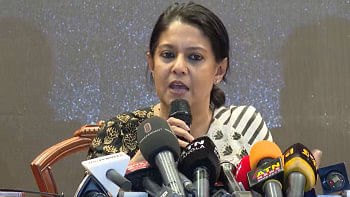Alternative facts and contradictory policies

Pick your deficit: The Finance Division has at long last published the Monthly Report on Fiscal Position with a full account of the fiscal outturns for FY19. It has come exactly seven and a half months late, but better late than never. The figures, however, leave one baffled. Fiscal deficit excluding grants plummeted to 3.9 percent of GDP in FY19, compared with 4.65 percent in FY18 and 4.1 percent in FY19. Deficit has declined not just as a percent of GDP but also in absolute taka amount (see Table-1) by nearly 6 percent relative to last fiscal year. This happened in year when the government allowed generous subsidies and tax waivers prior to the national elections. Yet revenue growth outpaced expenditure growth to yield a lower budget deficit.
So, where is the problem? This belies all expectations. But the bigger problem is that both the level and direction of change in fiscal deficit reported by the Bangladesh Bank (BB) in its Major Economic Indicators are exactly the opposite of what we have from the Finance Division. BB’s estimate, based on the financing side, says fiscal deficit increased from 3.89 percent of GDP in FY18 to 4.5 percent in FY19 and that the level of deficit in FY19 was 30.5 percent higher than in FY18. The BB is the banker of the government while the Finance Division is the treasurer. How can the estimates of these two arms be so different? Take a look at the FY19 financing numbers from these two sources in Table-2.
It is mind boggling to see such massive differences in estimates of net foreign financing and bank borrowing between the two institutions. Both institutions are represented in the Macro Fiscal Policy Coordination Council. Are these numbers not discussed in their meetings? Doesn’t anyone feel any need to reconcile the differences between these estimates? The fiscal policy adjustments warranted by falling deficit is obviously different from the one warranted by rising deficit.
The mind boggles even more when you look at the actuals on the NBR revenues and the ADP expenditures from different government sources.

NBR revenue collection in FY19 amounted to Tk 2,238.92 billion according to the BB and Tk 2,187 billion according to the Finance Division—a difference of Tk 51 billion which is more than twice the amount of supplementary duties reported to have been collected in FY19 by the Finance Division. Differences between the numbers on ADP expenditure reported by the Implementation Monitoring and Evaluation Division (IMED) and the Finance Division are even more dramatic—Tk 1,583.7 billion and Tk 1,135.2 billion respectively. The Finance Division data suggests that the implemented size of the ADP in FY19 was 5 percent lower than in FY18 while the FY19 ADP budget was 32.2 percent higher than the FY18 ADP budget—speaking of intentions and realisations moving in opposite direction!
With such varied numbers on the same revenue and expenditure categories from different sources in the government, we really have all the wherewithal to construct what is known as “alternative facts” that could not be dismissed as falsehoods, untruths or delusions. If we use the BB estimate of the NBR revenues in the Finance Division’s fiscal table, the deficit estimate goes down to 3.7 percent of GDP while the IMED’s estimate of ADP expenditure in the Finance Division’s fiscal table raises the deficit to 5.7 percent of GDP!
If you pride yourself as a fiscal dove who likes pumping money aggressively into the system, borrow as much as possible, and spend the way to higher growth, you can pick 5.7 if you want to give credit to the government and pick 3.7 if you want to criticise the government for not pumping enough. The fiscal hawk who is much more reticent and wants to cut spending, reduce the deficit and borrow less, is well advised to choose the opposite strategy. As the pragmatic theory of truth says, the value of the truth in a proposition is determined according to its practical outcomes and the utility that it provides.
Pick your policy: To help bankers implement the single digit interest rate agenda, the finance minister promised to the bankers just a couple of weeks ago that 50 percent of the government funds will be kept in private banks at 6 percent rate of interest.
The government on January 14 placed a bill in parliament to bring the surplus money held by 61 state agencies to the national exchequer to use it for development projects. The surplus funds will have to be deposited to the national exchequer within three months of completion of a fiscal year. These agencies had Tk 2,188.39 billion in banks as deposits as of June 2019.
Are these two policies workable at the same time? When the state agencies transfer surplus funds to the national exchequer, those funds will be held under the Treasury Single Account (TSA) in the BB and will not be back to the banking system until the government releases them back to the agencies to implement development projects. But those funds won’t stay with them too long because after the end of the fiscal year, the agencies will have to transfer the surplus back to the TSA.
Not surprisingly, the decision evoked concerns from bankers who feared the transfer of these funds to the national exchequer would worsen the liquidity crunch and hinder the move to bring lending rates down to single digit.
So many transactions for so little money to achieve what ends?
The author is an economist.


 For all latest news, follow The Daily Star's Google News channel.
For all latest news, follow The Daily Star's Google News channel. 



Comments